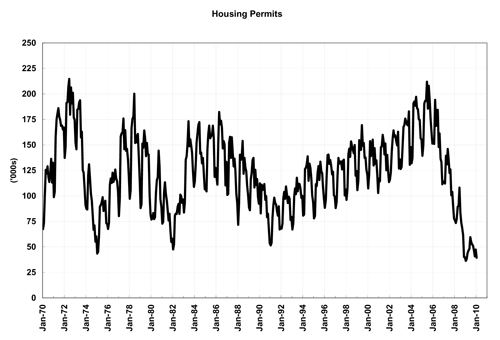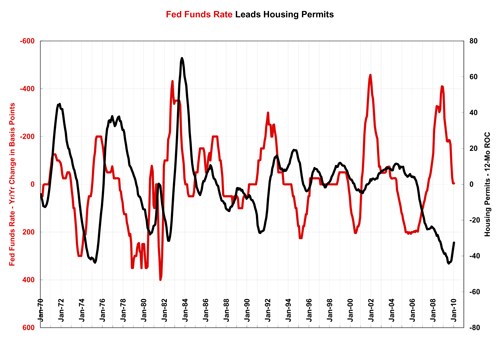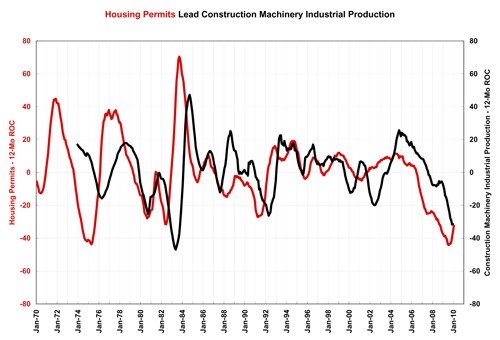Jan. 2010 Housing Permits Up 8.5%
Housing permits are a key leading indictor for construction machinery industrial production. According to the U.S. Census Bureau, housing permits in January 2010 were 39,400, an increase of 8.5% compared to January 2009.
Housing permits are a key leading indictor for construction machinery industrial production. According to the U.S. Census Bureau, housing permits in January 2010 were 39,400, which is an increase of 8.5% compared to January 2009. This marks the third straight month that permits have increased month on month. This is after seeing month on month permits decline by double digits for 41 consecutive months. However, as you can see on the first chart to the right, permits are still hovering near their lowest level in the last 40 years and more than 80% below the peak level of permits in 2005. Housing permits falling to this low level is not uncommon. What is uncommon is lengthy boom period throughout the 1990s and early 2000s.
Housing starts are quite seasonal, so it is helpful to use 12-month rate of change curves to compare housing permits with other data series. The second chart on the right compares the year-over-year change in the Fed funds rate (set by the Federal Reserve) to the 12-month rate of change for housing permits. A negative change (or decline in interest rates) is at the top of the chart because lower interest rates typically boost activity in the economy. The chart shows that as rates fall (the red line going up) housing permits grow faster and faster and vice versa.
On average, changes in interest rates lead changes in housing permits by 12 months. However, this relationship has broken down the past few years. I believe this is because consumers have so much debt that their purchasing decisions are no longer interest rate sensitive. Consumers are having a difficult time servicing their current debt levels so they don’t want to add any more debt. The current trend in the year-over-year change in interest rates should indicate an accelerating contraction in housing permits. However, we are seeing the rate of contraction in housing permits decelerate, which is just the opposite of what we’d expect. I believe this is because of the unprecedented support the government is providing to the housing market. Housing permits have maintained their current level because of the first-time home buyer tax credit, the Federal Reserve buying mortgage-backed securities, the new government guarantee on Fannie Mae and Freddie Mac debt and other measures. The first two measures listed will be coming to an end in the next couple of months.
As I mentioned above, housing permits are a very good leading indicator for construction machinery industrial production. The third chart to the right shows the relationship between the two data series. On average, changes in housing permits lead changes in construction machinery industrial production by eight months. For those that make a significant number of parts for construction machinery, monitoring changes in housing permits will give you a heads up on the direction of your business. The rate of change for housing permits bottomed in July 2009. It appears that the rate of change for construction machinery industrial production bottomed in December of 2009.
Read Next
The Cut Scene: The Finer Details of Large-Format Machining
Small details and features can have an outsized impact on large parts, such as Barbco’s collapsible utility drill head.
Read More3 Mistakes That Cause CNC Programs to Fail
Despite enhancements to manufacturing technology, there are still issues today that can cause programs to fail. These failures can cause lost time, scrapped parts, damaged machines and even injured operators.
Read More
.JPG;width=70;height=70;mode=crop)












.png;maxWidth=300;quality=90)










